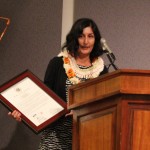2015 Hawaii Invasive Species Awareness Week Award Recipients
Community Hero: Charlotte Yamane
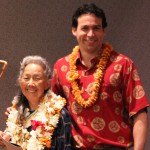
Charlotte Yamane and Representative Chris Lee
Charlotte has tirelessly devoted hundreds of hours volunteering to remove invasive plants from forests all over Oahu. She has extensive natural resource knowledge and skills, which she both shares as an inspiring teacher and puts into action as a dedicated volunteer. She has contributed her expertise to many organizations including the Oahu Invasive Species Committee, Oahu Army Natural Resources Program, The Nature Conservancy, Department of Land and Natural Resources, Plant Extinction Prevention Program, Hawaiian Trail and Mountain Club, Ohulehule Forest Conservancy, Manoa Cliffs Restoration Project, and Kualoa Ranch. Charlotte has been a leader and contributed extensively to the removal of albizia from Kaaawa and Hakipuu Valleys clearing the way for the recovery of the native ecosystems. Long term impacts of Charlotte’s work includes increasing the knowledge of invasive species and native plants and animals among the public and local businesses through outreach and healthier watersheds mauka to makai through removal of invasive species. Leading by example, she has taught and encouraged many other volunteers to learn about and remove invasive species as well.
Community Hero Honorable Mention: Laurie Loomis
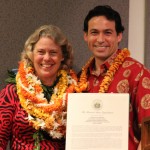
Laurie Loomis and Representative Chris Lee
Laurie’s passion, energy, and enthusiasm for protecting and restoring native forests on Oahu is inspiring and contagious. She volunteers several times a month with Oahu Army Natural Resources Program (OANRP) to control invasive species across the Waianae Mountain Range and joins staff with the Natural Area Reserve Program anytime extra hands are needed. In addition, she is a core member of the community restoration Manoa Cliffs Project. She can be found there every Sunday without fail, helping to remove invasive weeds or re-introducing native plants into this important section of native forest in the Koolau Mountains. Impacts of her work include increasing the supply of native plants available for out planting and helping native forests in both the Waianae and Koolau range gain important ground. Additionally, her influence on recruiting fellow volunteers will go a long way, insuring that Oahu has a steady, committed group of citizens, willing to get dirty and do the hard work of protecting and preserving our native forests.
Business Leader: Hawaiian Airlines

George Kaanana, Hawaiian Airlines and Representative Richard Onishi
Hawaiian Airlines has been a leader in the area of prevention of invasive pest species movement for years through its positive collaborations with the Hawaii Department of Agriculture (HDOA). This has included showing inflight videos highlighting invasive species issues in addition to promoting the filling out of Agricultural Declaration Forms. Hawaiian Airlines has also been a positive force in terms of allowing HDOA access to air cargo areas for the inspection of commodities moving interisland. This year Hawaiian Airlines went above and beyond by supporting HDOA’s increased inspections of interisland cargo to identify high-risk pathways for little fire ants. They were invaluable in making cargo available for inspections at the times needed by inspectors. This partnership allowed HDOA to analyze what the high risk commodities are, how they are moving, where they are moving from, and what pathways pose a risk for the spreading of invasive species through air cargo. They also participated in an early study of electronic manifesting of air cargo with HDOA. Electronic manifesting of air cargo is the future that HDOA needs to move toward in order to achieve a more efficient, effective biosecurity program that can operate leaner without compromising agricultural industries or the environment. Hawaiian Airlines, with its willingness to support electronic manifesting as well as biosecurity facilities is not just a private industry leader in the area of biosecurity, but a national leader as no other air carrier has been willing to push for electronic manifesting or biosecurity facilities. To Hawaiian Airlines it just makes good business sense as faster clearing of cargo means better business relations while being good stewards of the environment and the broader community. Hawaiian Airlines is one of the largest air carriers moving cargo into Hawaii. It’s proactive stances and willingness to work with HDOA sets a shining example that other air carriers should model themselves after. Their proactive stances and advocacy will help drive a better biosecurity system for generations to come.
Greatest Hit: Carmel Partners and Island Topsoil

Tom LeFevre, Carmel Partners, Lorra Naholowaa, Island Topsoil, and Senator Mike Gabbard
In June of 2014, a major Coconut Rhinoceros Beetle (CRB) breeding site was identified at Iroquois Point on land managed by Carmel Partners. Since the discovery, the property management company has worked tirelessly with Island Topsoil to follow all necessary CRB procedures. As of early January 2015, the site is considered to be completely mitigated with all suitable breeding habitat being removed and no more active breeding occurring there. Thousands of CRB were removed and the site will never be re-infested. In the short term, the impact on the population of CRB will be great as thousands of larvae, pupae, and adults have been eliminated, and a major breeding site has been removed. In the long term, this work will set the stage for further successes in the eradication of CRB from Oahu. Both Carmel Partners and Island Topsoil are leading examples in the business community of partnering with the government to effectively protect Hawaii’s natural environment and the community.
Hottest Hotline Report to 643-PEST: Rick Yamamoto, HI Air National Guardsmen
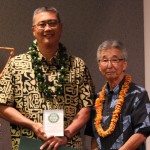
Rick Yamamoto and Representative Clift Tsuji
In June of 2014, Rick Yamamoto took quick action when he observed what was described as a 2-foot long, black lizard with a black tongue running across the pavement at Joint Base Pearl Harbor-Hickam. He immediately photographed the animal and it was reported right away to HDOA through the 643-PEST hotline. Thanks to this rapid response, Keevin Minami, HDOA Land Vertebrate Specialist, was able to apprehend the 24” long juvenile water monitor lizard the next day, preventing a very harmful invasive species from escaping into Hawaii’s environment. According to Keevin “If Rick had not rapidly called in his observation and shared a photo to allow for a positive, rapid assessment/ID of the Monitor Lizard, it could have ended up in the nearby mangroves and never been captured.” This award especially highlights the theme of HISAW that invasive species are everyone’s kuleana. We depend on the eyes and ears of the public to report any sightings of new or unusual plants and animals. If you think you’ve spotted a potential pest, please kokua and call 643-PEST to report it and malama the aina.
Hawaii Island MVP: Rich Wlosinski, HELCO
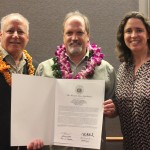
Senator Russell Ruderman, Rich Wlosinski, HELCO, and Springer Kaye, BIISC
Rich has been an exceptional major contributor to the Hawaii Island-wide albizia mitigation plan. He contributed many hours to assessing risks and costs of albizia hazard removal, as well as developing strategies for the most cost-effective methods of approaching hazardous albizia infestations. As the HELCO system forester, Rich changed the way HELCO contractors were instructed to manage albizia along power lines and roads to achieve better long-term outcomes. His input to a multi-agency albizia task force was key in planning for future actions that will significantly impact the albizia issue on Hawaii Island. His strategies will reduce costs for albizia management for a broad range of stakeholders. Under his direction, HELCO directly contributed time and resources to prove the effectiveness of these methods and value of interagency cooperation.
Maui Nui MVP: Maui HDOA Plant Quarantine Inspectors

Marshall Loope and Senator J. Kalani English
The work of a plant quarantine inspector is extremely demanding: the hours are long as cargo arrives at all hours of day or night, plants and insects arriving from many different places demands impressive taxonomic identification skills, and cargo arrives in fast and in great volumes necessitating trade-offs and a hectic pace. Often inspectors work unprotected in the hot sun at the harbor, or late into the night sorting through quarantine forms from incoming red-eye flights. Despite these challenges, the HDOA inspectors on Maui regularly go above and beyond. The Maui Inspectors have become particularly adept at finding little fire ants, keying in on interisland shipments from infested areas in the state. A particularly impressive detection occurred on hapuu shipped to Maui in July of 2014. Inspectors put out peanut butter bait as usual, but even though no ants came to the bait, they did a thorough visual inspection and discovered LFA. Noting the infested hapuu were the third shipment to a local nursery, inspectors went straight to the nursery to search the other shipments and discovered LFA on 7 out of 100 hapuu on site and ready to be sold. Luckily, none of the hapuu from the infested shipments had been sold and inspectors worked with the nursery owner to eradicate the ants. This is only one example of how Maui inspectors have taken a proactive role in addressing the spread of little fire ant between islands. They have found LFA in shipments of various materials, including vehicles, cut flowers, and a queen LFA on pineapple, indicating for the first time that LFA colonies could be spread via produce. Their diligence is not limited to LFA; Maui inspectors regularly prevent devastating insects, pathogens, and even animals illegally shipped to Maui from ever leaving the harbor or airport. Without their effort, Maui would be a much different place.
Inspectors: Kyle Yagi, Supervisor, Catherine Davenport, Ian Fujimori, Bert Fujioka, Marshall Loope, Matthew Olbert, Michael Pruett, Wayne Uradomo, Bob Yonahara
Oahu MVP: The Coconut Rhinoceros Beetle Response: USDA APHIS, HDOA, and JBPHH

The CRB Response Team leadership representing USDA APHIS, HDOA, and JBPHH with Senator Laura Thielen
The Coconut Rhinoceros Beetle (CRB), a serious invasive pest, was detected on December 23, 2013 at Joint Base Pearl Harbor – Hickam (JBPHH) on coconut trees. Immediately following the detection, an emergency response effort between the U.S. Department of Agriculture (USDA), the U.S. Navy, the Hawaii Department of Agriculture (HDOA) and other partners mobilized surveying, trapping and control in the area where the beetle was found. An Incident Command System (ICS) was been established to help manage the various agencies and activities needed to efficiently respond and has resulted in groundbreaking collaborative and coordinated leadership between USDA APHIS, HDOA, and JBPHH. Since January 2014, the program has deployed 89 bucket/barrel traps and serviced them a total of 3,005 times, and 2,667 panel traps have been serviced a total of 43,651 times. They have surveyed 95,295 palms in 256 square miles of accessible land on Oahu, and detected 126 damaged palms, 162 standing dead and stumps, and removed 133 of them to date. In addition, breeding site surveys have located 291 potential, but not currently infested mulch piles, and 9 active breeding sites. Of those 9 active breeding sites, all have been, or are in the process of being destroyed and removed. 3,520 cubic yards of mulch have been eliminated using in-vessel composting, and over 100 tons of green waste has been destroyed in an air curtain burner. Since the first detection of a beetle in a trap, and the subsequent discovery of a breeding site at JBPHH, 1220 adult, 1550 larvae, and 25 pupae have been found on base, and 66 adults have been found off base. Not including media releases and web-casts, 60 outreach events have been conducted, reaching an estimated 6,200 people directly. An estimated 90,000 person hours have been expended on eradication activities since this program began. The enormous and unprecedented progress made in this program would not have been possible without the dedicated network of partners, the CRB field survey team, and the supportive leadership from USDA, HDOA, and JBPHH.
Kauai MVP: Michelle Clark, US FWS
Michelle has been a strong leader in the mongoose detection and prevention efforts on Kauai. Currently, Kauai and Lanai are the only major Hawaiian Islands without known, established populations of the highly devastating mongoose. The work to detect any possibly established animals and prevent introductions is key to keeping it that way. Michelle has initiated a review of mongoose prevention, detection and control for Kauai and networked with state, federal, and private organization staff to form a working group. Her efforts are freeing up long-held mitigation money from an oil spill, which will fund an international summit on mongoose management bringing experts and knowledge from around the world to the benefit of both Kauai and statewide efforts. This meeting will occur in the spring of 2015 and will generate a monitoring and prevention plan that will greatly increase the chances that Kauai remains mongoose free.
2014 NATIONAL INVASIVE SPECIES ACHIEVEMENT AWARD, Outstanding Achievement in Invasive Species Outreach and Education: Christy Martin, CGAPS
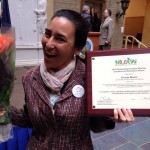
Christy Martin
Christy Martin is a game-changer for invasive species work in Hawaii. She has spent her career working tirelessly to promote and progress critical issues on all fronts of the field. Through her direction of the Coordinating Group on Alien Pest Species she brings together a powerful collaboration of state, federal, and private entities to catalyze action and positive change. Additionally, in the past year she set up a framework for outreach in the emergency response to Coconut Rhinoceros Beetle and initiated and leads the Outreach Group for the emergency response to little fire ants on Oahu. Under her guidance this group has participated in over 80 outreach events reaching over 5,000 people since February 2014. Christy is an inspiration to all those working on invasive species issues in the state. Her work is highly respected and her efforts in supporting the emergency responses this year have underscored her critical role. Hawaii’s residents and government officials are better informed and better prepared thanks to Christy.
This is the first time a Hawaii representative has received a National Invasive Species Achievement Award and she will be honored by the Department of the Interior and the United State Department of Agriculture in Washington DC on Wednesday February 25, 2015.
